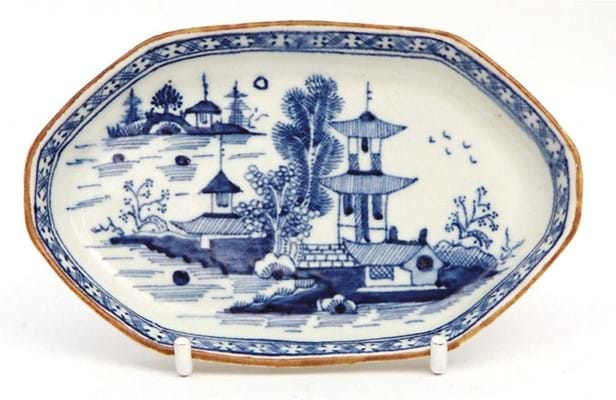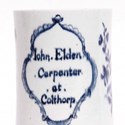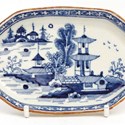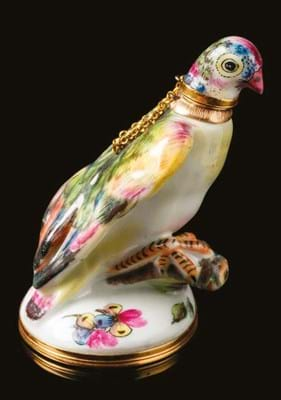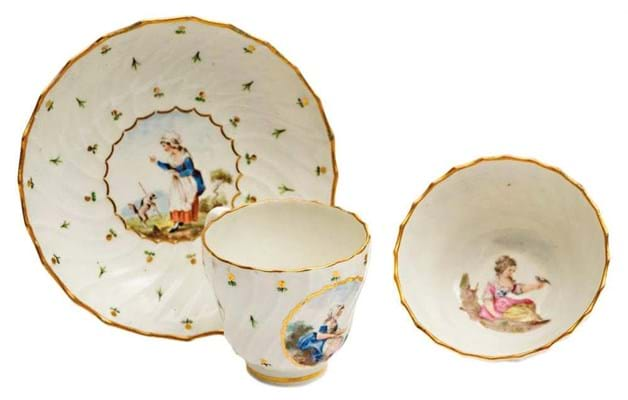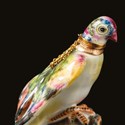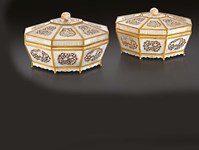Although the performance of much of this material does what it says on the tin, keen-eyed bidders aided by the reach of the internet can winkle out less obvious prizes. And if enough people spot them (although only two determined contestants are actually required), their scarcity will be recognised in the final hammer price.
Shown here is a selection of high-flyers from sales around the regions in recent weeks. Some are early pieces from known factories such as Chelsea or Lowestoft with the requisite desirable features to tempt bidders. Others appear in the catalogues with more speculative cataloguing but with their identity evidently recognised by specialist eyes.
Local pull of Lowestoft
Lowestoft porcelain has traditionally enjoyed a strong local collecting base so it was no surprise to find a sizeable ensemble of around 40 lots featured in the English ceramics section of Keys’ (20% buyer’s premium) three-day spring sale at Aylesham from March 27-29. It comprised two collections both put together some decades ago.
A big price variation exists for the pieces from this factory: from the standard late 18th century sprig decorated tablewares that sell for a few hundred pounds to the sought-after classes that were a factory speciality and can run to several thousand.
The latter include small models of animals and pieces that are dated and inscribed, often created as special commissions to commemorate a marriage, a birth or as ‘a Trifle from Lowestoft’ souvenir.
Keys’ sale had both. Best-seller at a predicted £5000 was an underglaze-blue decorated 4in (11cm) high tapering mug, a piece that ticked many of the right boxes. It was inscribed in a cartouche John Elden Carpenter at Colthorp.
Elden is recorded as being buried in Colthorpe Churchyard in 1788 and the auction house had dated this piece (which was perhaps produced for Elden in a professional capacity) to c.1765. It is the only recorded example of a mug that also includes the named person’s occupation.
A classic polychrome decorated Trifle from Lowestoft inkwell achieved £3000 and a manganese sponged figure of a seated pug £2000.
Also proving popular (and in this case making well in excess of its £400-600 guide) was a 5in (13cm) long lozenge-shaped spoon tray decorated with a Chinese-inspired underglaze blue pagoda pattern. Blue and white spoon trays are unusual in the Lowestoft oeuvre, noted Keys’ specialist David Broom, and this one ended up making £1350.
Beyond local porcelain prizes the sale also recorded a £3000 price for a piece of early Worcester: an underglaze blue decorated mug of ‘scratch cross’ type.
Desirable as early, with the bonus of a face mask moulded to the lower terminal, it was nonetheless damaged and riveted. Broom felt the final price illustrated how much rarity can overcome condition.
Another ceramic high-flyer came in the pottery section. A 11in (28cm) ochre slip-decorated pottery jug was incised with a galleon in full sail and rudimentary flowering branches.
The piece was unmarked but Keys had suggested an attribution to the 19th century West Country potter Edwin Beer Fishley. Broom kept the estimate at a modest £150-200 but thought this could well be surpassed. Internet, room and four phones contested the piece which ended up selling to a dealer for £3900.
“Keen-eyed bidders aided by the reach of the internet can winkle out less obvious prizes
Early Bow in south London
Just over 100 lots of English and Continental ceramics and glass were included in Roseberys’ (25/20/12% buyer’s premium) fine and decorative sale held in south London on March 21.
This was a typical mix of tablewares and figures from the major 18th and 19th century factories but the highest price came with a more tentative attribution.
Two porcelain shell and dolphin moulded sculptural salts were described as English porcelain and ascribed possibly to the Bow factory with an equally tentative £200-300 guide.
They ended up making no less than £8200. The successful purchaser, bidding on the phone, was the specialist London dealer in English and Continental ceramics Errol Manners, who not only confirmed the Bow attribution but explained why they made so much.
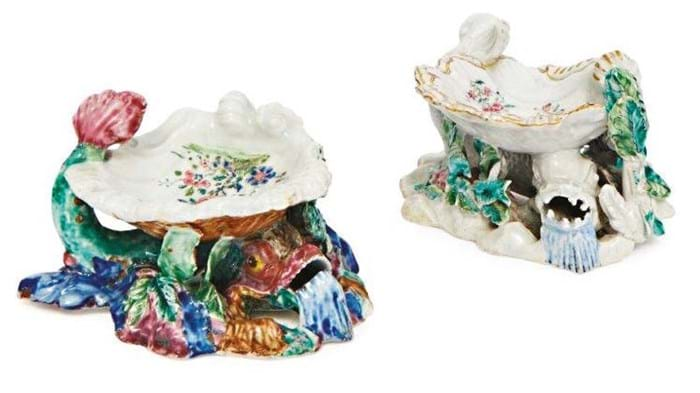
Pair of very early Bow shell salts – £8200 at Roseberys.
The shell salts are of a type known as mushroom or drab glazed ware and are generally accepted as the earliest known pieces of Bow porcelain, dated to 1746-47.
Only around 30 pieces are known but these salts are some of the most ambitious examples to have survived, said Manners, as the others are much simpler forms such as cane handles and leaf shaped pickle dishes. “They are really very special,” he said, adding that he would have been prepared to pay more.
A £200-300 estimate was also given to a pair of unattributed English porcelain rococo style polychrome decorated figures of a young girl and boy dated to the 18th century that realised £2500.
A pair of delft plates painted with primitive landscape and house scenes described as English or Dutch were also popular, probably because they were both inscribed and dated.
The 8in (21cm) diameter plates, which were described as being initialled AB and possibly dated 1733 or initialled JJ33, were hammered down at £2900, over 10 times the estimate.
Toys and children
The 18th century gold or gilt metal mounted scent bottles or ‘toys’ once ascribed to Chelsea but now also attributed to the St James factory of Charles Gouyn, continue to attract keen bidding at the rostrum.
An example was on offer in Bearnes, Hampton & Littlewood’s (21% buyer’s premium) spring sale in Exeter on April 17, a typically brightly plumed parrot-like bird with the head forming the stopper linked to the body by a gilt metal collar and chain. It realised £4700 against an £800- 1200 guide.
The painting skills of Belgian-born artist Fidele Duvivier, who worked variously at the Derby and New Hall factories and independently as an outside decorator, have been widely acknowledged as adding a premium to any pieces ascribed to his hand.
The spiral fluted teacup, coffee cup and saucer dated to c.1792 which also featured in the BHL sale came from a service that was attributed to the Caughley factory but is thought to have been an example of its production that was sent away as blanks to be decorated at the Chamberlain factory.
The decoration of delicate roundel portraits is thought to have been painted by Duvivier during his very brief tenure at Chamberlains.
The BHL trio bore a label for the Godden reference collection. The celebrated English porcelain specialist and author Geoffrey Godden was interested in Duvivier’s work and discussed this service, elements of which he acquired, in his publication Chamberlain-Worcester porcelain.
Bonhams has also sold several pieces from the service including a tea canister which realised £3800 in 2013.
All these features helped to propel the trio to a double-estimate price of £3100.



